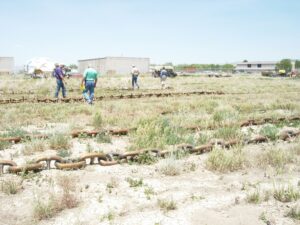Description
Used anchor chains are commonly utilized for brush and tree control, smoothing disturbed land (e.g., rootplowing), and/or seedbed preparation. Anchor chains are most effective in decadent stands of non-sprouting brush or thick stands of older trees that have encroached sagebrush habitats. Chaining has high production (acres/hr) and relatively low cost.
Chains are sized by the diameter of the round stock, and sizes range from 1 to 6 inches. Revegetation projects normally use chain sizes between 2 and 3 inches. Within this range, individual links are 12 to 18 inches in length and weigh between 25 and 86 pounds. The resulting weight per foot of chain is about 37 to 88 pounds, respectively. Anchor chain is usually sold in 90-foot lengths called “shots.” Further specifications on weight and link size are listed in Appendix.
Application
Anchor chains are pulled in a “U” shape between two tractors or dozers. The distance between the two tractors depends on the force required to pull the chain. An initial distance of 1/3rd the length of the chain is a rule-of-thumb. Size and length of the chain are factors as well as the size of the tractors. The distance between tractors can be greater when preparing a seedbed than when felling trees. Chain length is usually between 200 to 400 feet. Length can be adjusted easily with standard cutting and welding tools. Crawler tractors used for chaining vary from 140 to 350 horsepower. Production rates vary widely between 10 and 70 acres/hour. Chaining a second time in the opposite direction increases the effectiveness of removing tree stumps and can be useful in increasing soil disturbance for seeding (see Anchor Chains and Modified Chains sections of Site Preparation). Chaining is not effective on trees with limber trunks. Chaining is very cost effective especially on large areas. It is more effective when combined with raking, herbicides, or fire to control sprouting shrubs.
Used anchor chain can be purchased from marine supply or salvage companies located in coastal cities of the United States.
Considerations:
- There are several chain configurations. Options include Ely chains (welded cross bar) and smooth chains. Both types of chains are available in different link sizes depending on the desired weight. Ely chains and heavier chains cause more ground disturbance, and can also be more difficult to pull (heavier does not necessarily mean better).
- Ensure the tractor/dozer is paired appropriately with the chain type/weight, treatment, and terrain. Both horsepower and weight of tractors/dozers need to be specified on contracts to ensure they are capable of accomplishing the project.
- Chaining for shrub or tree control is most effective on older plants. Young, supple plants will often remain and be released. Chaining should not be used on sprouting shrubs.
- Tree chaining typically requires two passes in opposite directions to fully uproot trees. Full to partial control of shrub species is possible by increasing or decreasing the number of passes.
- Proper operation is critical. The chain should be pulled in a “U” or “J” shaped pattern. When pulled too straight, the chain is uplifted and skips over the vegetation and soil. Chains should maintain contact with the soil for maximum vegetation control.
References / Additional Information
Roby, G.A.; Green, L.R. 1976. Mechanical methods of chaparral modification. Agric. Handbook 487. U.S. Department of Agriculture, Forest Service. 46 p.
Stevens, R.; Monsen, S.B. 2004. Chapter 9. Mechanical plant control. In: Monsen, S.B.; Stevens, R.; Shaw, N.L., comps. Restoring western ranges and wildlands, vol. 1. Gen. Tech. Rep. RMRS-GTR-136-vol-1. Fort Collins, CO: U.S. Department of Agriculture, Forest Service, Rocky Mountain Research Station. p. 65-88.


